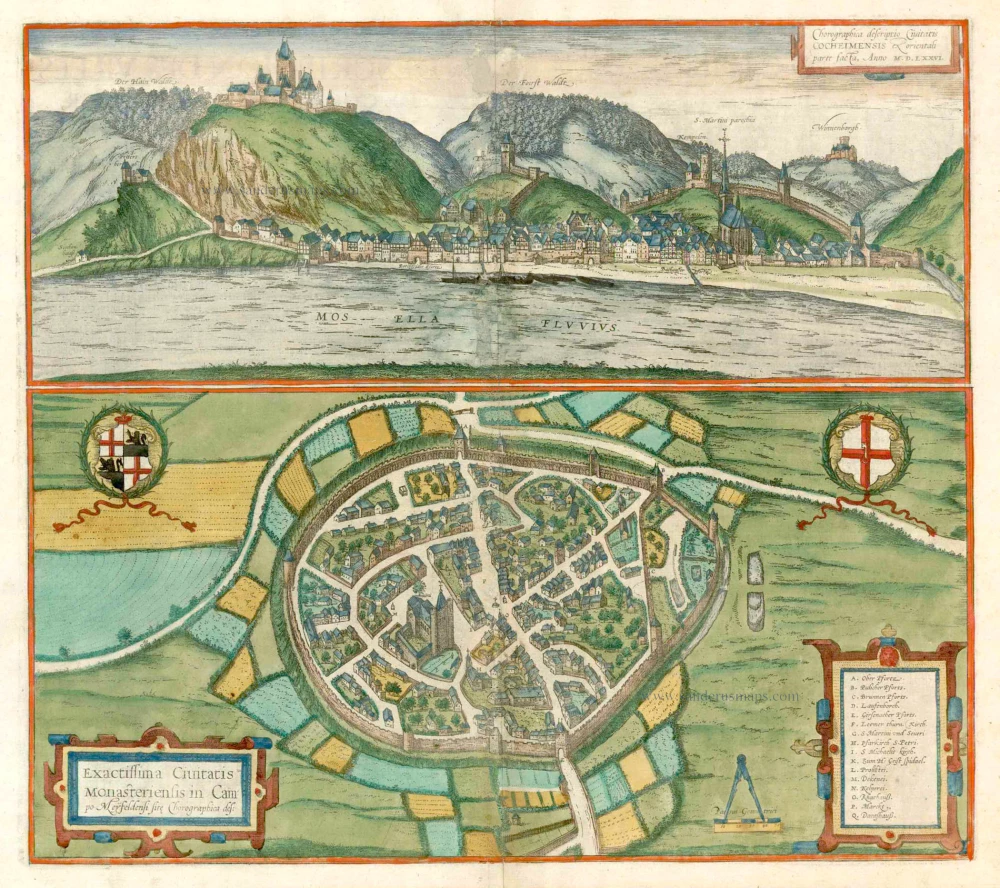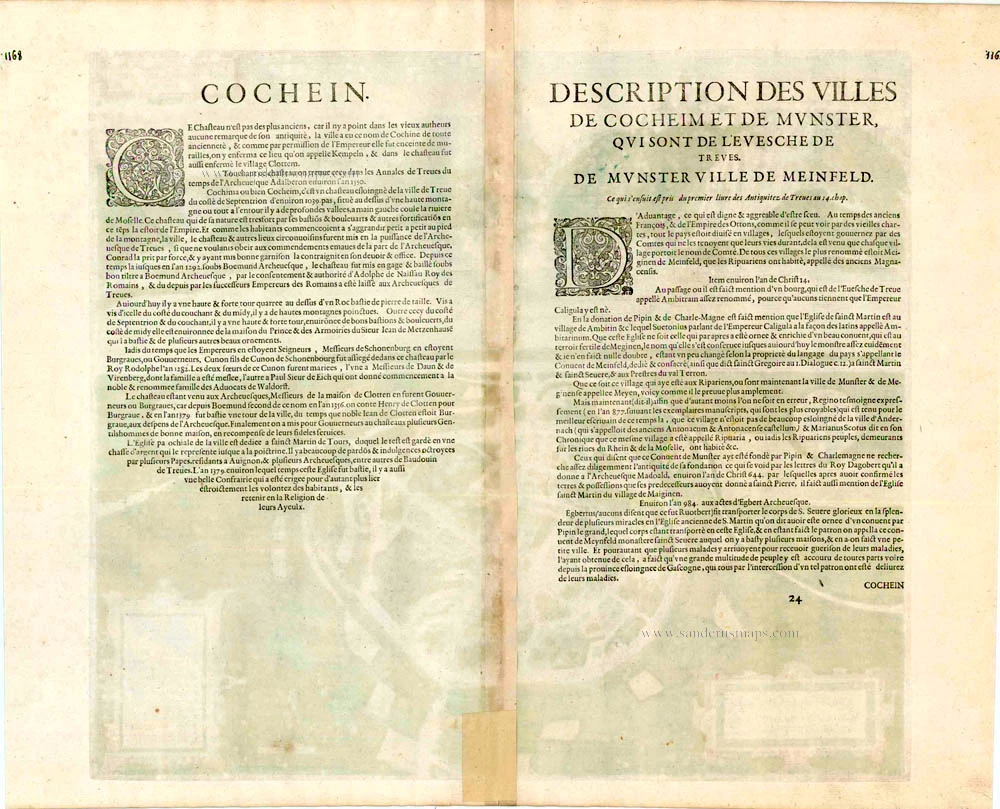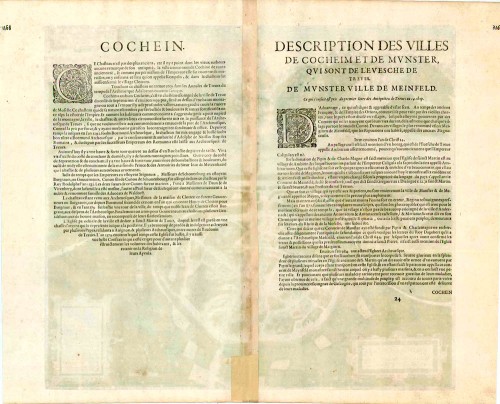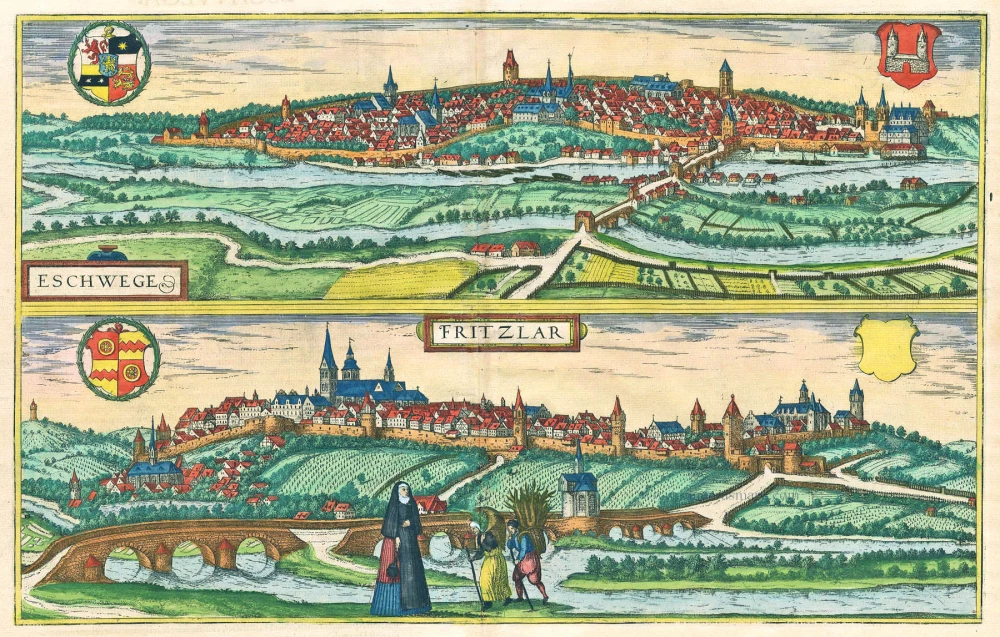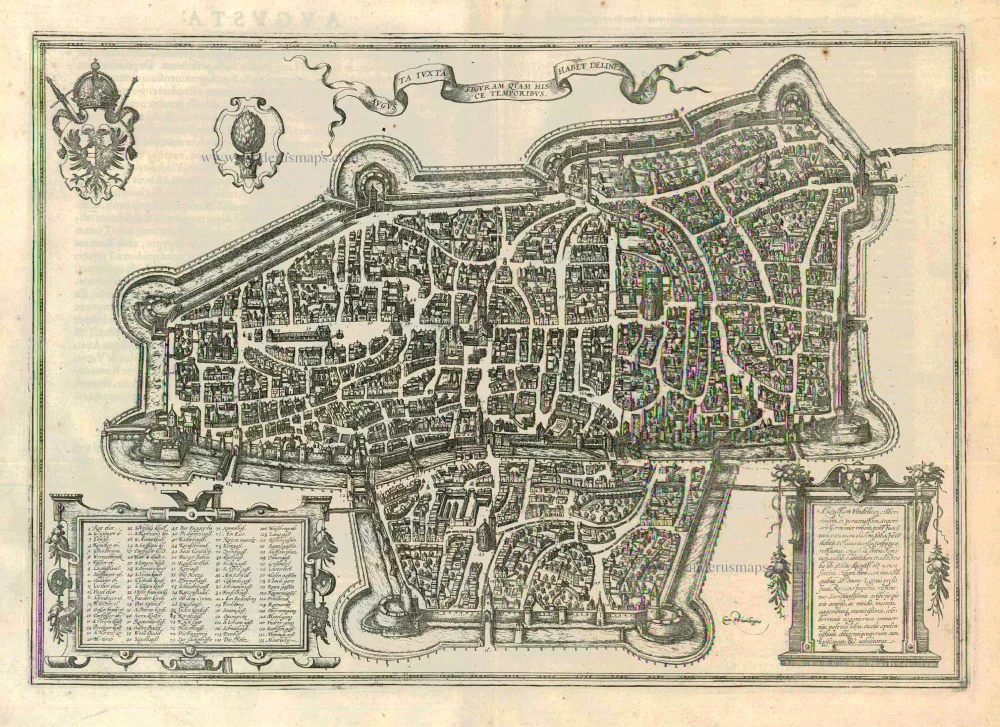Cochem and Münstermaifeld, by Georg Braun and Frans Hogenberg. c. 1610
COCHEM
TRANSLATION OF CARTOUCHE TEXT: Panorama of the town of Cochem seen from the east. In the year 1576.
COMMENTARY BY BRAUN (on verso): "Cochem was originally a castle on a high mountain beside a deep valley, through which the Moselle flows along the left-hand side. This castle, which is very well protected by its natural location and by walls and ramparts, dates from the Roman Empire."
Cochem is presented from the east, from the right bank of the Moselle. With its 11th-century fortress high overhead, the town, which is first mentioned in records in AD 886, is considered one of the loveliest on the Moselle. The half-timbered houses of the Old Town and the parish church of St Martin, originally founded by the Franks, are rendered in loving detail. Here still visible on a hill on the far right, is the Winneburg fortress from the second half of the 13th century, like Cochem castle, it was destroyed in the War of Palatine Succession but in this case, was not rebuilt. A number of the many city gates captioned in the engraving have survived right up to the present.
MÜNSTERMAIFELD
CARTOUCHE LEFT: Accurate illustration of the town of Münstermaifeld in Maifeld.
COMMENTARY BY BRAUN (on verso): "A deed of donation by Pippin and Charlemagne mentions the church of St Martin in the village of Ambitio. Undoubtedly, it refers to this church, which was later invested with a very wealthy college and became known under the slightly different name of the Maifeld minster."
In contrast to Cochem, Münstermaifeld - granted the right to hold a market in AD 965 and a municipal charter in 1277 - is presented in a bird's-eye view from the northwest. The former Gothic collegiate church of SS Martin and Severus is clearly recognisable with its well-fortified west end (G). From 956, it housed the relics of St Severus, which made Münstermaifeld a pilgrimage centre. Many historical buildings survive in their original state, including the medieval town hall (O), vestiges of the city wall and the provost (L), today the museum of local history and culture. Münstermaifeld is also known due to its proximity to Eltz castle, one of the loveliest in Germany. (Taschen)
Braun G. & Hogenberg F. and the Civitates Orbis Terrarum.
The Civitates Orbis Terrarum, also known as the 'Braun & Hogenberg', is a six-volume town atlas and the most excellent book of town views and plans ever published: 363 engravings, sometimes beautifully coloured. It was one of the best-selling works in the last quarter of the 16th century. Georg Braun, a skilled writer, wrote the text accompanying the plans and views on the verso. Many plates were engraved after the original drawings of a professional artist, Joris Hoefnagel (1542-1600). The first volume was published in Latin in 1572 and the sixth in 1617. Frans Hogenberg, a talented engraver, created the tables for volumes I through IV, and Simon van den Neuwel made those for volumes V and VI. Other contributors were cartographers Daniel Freese and Heinrich Rantzau, who provided valuable geographical information. Works by Jacob van Deventer, Sebastian Münster, and Johannes Stumpf were also used as references. Translations appeared in German and French, making the atlas accessible to a broader audience.
Since its original publication of volume 1 in 1572, the Civitates Orbis Terrarum has left an indelible mark on the history of cartography. Seven more editions followed the first volume in 1575, 1577, 1582, 1588, 1593, 1599, and 1612. Vol.2, initially released in 1575, saw subsequent editions in 1597 and 1612. The subsequent volumes, each a treasure trove of historical insights, graced the world in 1581, 1588, 1593, 1599, and 1606. The German translation of the first volume, a testament to its widespread appeal, debuted in 1574, followed by the French edition in 1575.
Several printers were involved: Theodor Graminaeus, Heinrich von Aich, Gottfried von Kempen, Johannis Sinniger, Bertram Buchholtz, and Peter von Brachel, all of whom worked in Cologne.
Georg Braun (1541-1622)
Georg Braun, the author of the text accompanying the plans and views in the Civitates Orbis Terrarum, was born in Cologne in 1541. After his studies in Cologne, he entered the Jesuit Order as a novice, indicating his commitment to learning and intellectual pursuits. In 1561, he obtained his bachelor's degree; in 1562, he received his Magister Artium, further demonstrating his academic achievements. Although he left the Jesuit Order, he continued his studies in theology, gaining a licentiate in theology. His theological background likely influenced the content and tone of the text in the Civitates Orbis Terrarum, adding a unique perspective to the work.
Frans Hogenberg (1535-1590)
Frans Hogenberg was a Flemish and German painter, engraver, and mapmaker. He was born in Mechelen as the son of Nicolaas Hogenberg.
By the end of the 1560s, Frans Hogenberg was employed upon Abraham Ortelius's Theatrum Orbis Terrarum, published in 1570; he is named an engraver of numerous maps. In 1568, he was banned from Antwerp by the Duke of Alva and travelled to London, where he stayed a few years before emigrating to Cologne. He immediately embarked on his two most important works, the Civitates, published in 1572 and the Geschichtsblätter, which appeared in several series from 1569 until about 1587.
Thanks to large-scale projects like the Geschichtsblätter and the Civitates, Hogenberg's social circumstances improved with each passing year. He died as a wealthy man in Cologne in 1590.
Chorographica Descriptio Civitatis Cocheimensis [on sheet with] Exactissima Civitatis Monasteriensis in Campo Meyfeldensi Chorographica Des.
Item Number: 16747 Authenticity Guarantee
Category: Antique maps > Europe > Germany - Cities
Old, antique bird’s-eye view plan of Cochem and Münstermaifeld, by Georg Braun and Frans Hogenberg.
Title: Chorographica Descriptio Civitatis Cocheimensis [on sheet with] Exactissima Civitatis Monasteriensis in Campo Meyfeldensi Chorographica Des.
Date of the first edition: 1596.
Date of this map: c. 1610.
Copper engraving, printed on paper.
Size (not including margins): 370 x 418mm (14.57 x 16.46 inches).
Verso: French text.
Condition: Contemporary coloured, some smudging at upper centre.
Condition Rating: B.
From: Théâtre des Principales Villes de tout l'Univers. Tome 5. c. 1610.
COCHEM
TRANSLATION OF CARTOUCHE TEXT: Panorama of the town of Cochem seen from the east. In the year 1576.
COMMENTARY BY BRAUN (on verso): "Cochem was originally a castle on a high mountain beside a deep valley, through which the Moselle flows along the left-hand side. This castle, which is very well protected by its natural location and by walls and ramparts, dates from the Roman Empire."
Cochem is presented from the east, from the right bank of the Moselle. With its 11th-century fortress high overhead, the town, which is first mentioned in records in AD 886, is considered one of the loveliest on the Moselle. The half-timbered houses of the Old Town and the parish church of St Martin, originally founded by the Franks, are rendered in loving detail. Here still visible on a hill on the far right, is the Winneburg fortress from the second half of the 13th century, like Cochem castle, it was destroyed in the War of Palatine Succession but in this case, was not rebuilt. A number of the many city gates captioned in the engraving have survived right up to the present.
MÜNSTERMAIFELD
CARTOUCHE LEFT: Accurate illustration of the town of Münstermaifeld in Maifeld.
COMMENTARY BY BRAUN (on verso): "A deed of donation by Pippin and Charlemagne mentions the church of St Martin in the village of Ambitio. Undoubtedly, it refers to this church, which was later invested with a very wealthy college and became known under the slightly different name of the Maifeld minster."
In contrast to Cochem, Münstermaifeld - granted the right to hold a market in AD 965 and a municipal charter in 1277 - is presented in a bird's-eye view from the northwest. The former Gothic collegiate church of SS Martin and Severus is clearly recognisable with its well-fortified west end (G). From 956, it housed the relics of St Severus, which made Münstermaifeld a pilgrimage centre. Many historical buildings survive in their original state, including the medieval town hall (O), vestiges of the city wall and the provost (L), today the museum of local history and culture. Münstermaifeld is also known due to its proximity to Eltz castle, one of the loveliest in Germany. (Taschen)
Braun G. & Hogenberg F. and the Civitates Orbis Terrarum.
The Civitates Orbis Terrarum, also known as the 'Braun & Hogenberg', is a six-volume town atlas and the most excellent book of town views and plans ever published: 363 engravings, sometimes beautifully coloured. It was one of the best-selling works in the last quarter of the 16th century. Georg Braun, a skilled writer, wrote the text accompanying the plans and views on the verso. Many plates were engraved after the original drawings of a professional artist, Joris Hoefnagel (1542-1600). The first volume was published in Latin in 1572 and the sixth in 1617. Frans Hogenberg, a talented engraver, created the tables for volumes I through IV, and Simon van den Neuwel made those for volumes V and VI. Other contributors were cartographers Daniel Freese and Heinrich Rantzau, who provided valuable geographical information. Works by Jacob van Deventer, Sebastian Münster, and Johannes Stumpf were also used as references. Translations appeared in German and French, making the atlas accessible to a broader audience.
Since its original publication of volume 1 in 1572, the Civitates Orbis Terrarum has left an indelible mark on the history of cartography. Seven more editions followed the first volume in 1575, 1577, 1582, 1588, 1593, 1599, and 1612. Vol.2, initially released in 1575, saw subsequent editions in 1597 and 1612. The subsequent volumes, each a treasure trove of historical insights, graced the world in 1581, 1588, 1593, 1599, and 1606. The German translation of the first volume, a testament to its widespread appeal, debuted in 1574, followed by the French edition in 1575.
Several printers were involved: Theodor Graminaeus, Heinrich von Aich, Gottfried von Kempen, Johannis Sinniger, Bertram Buchholtz, and Peter von Brachel, all of whom worked in Cologne.
Georg Braun (1541-1622)
Georg Braun, the author of the text accompanying the plans and views in the Civitates Orbis Terrarum, was born in Cologne in 1541. After his studies in Cologne, he entered the Jesuit Order as a novice, indicating his commitment to learning and intellectual pursuits. In 1561, he obtained his bachelor's degree; in 1562, he received his Magister Artium, further demonstrating his academic achievements. Although he left the Jesuit Order, he continued his studies in theology, gaining a licentiate in theology. His theological background likely influenced the content and tone of the text in the Civitates Orbis Terrarum, adding a unique perspective to the work.
Frans Hogenberg (1535-1590)
Frans Hogenberg was a Flemish and German painter, engraver, and mapmaker. He was born in Mechelen as the son of Nicolaas Hogenberg.
By the end of the 1560s, Frans Hogenberg was employed upon Abraham Ortelius's Theatrum Orbis Terrarum, published in 1570; he is named an engraver of numerous maps. In 1568, he was banned from Antwerp by the Duke of Alva and travelled to London, where he stayed a few years before emigrating to Cologne. He immediately embarked on his two most important works, the Civitates, published in 1572 and the Geschichtsblätter, which appeared in several series from 1569 until about 1587.
Thanks to large-scale projects like the Geschichtsblätter and the Civitates, Hogenberg's social circumstances improved with each passing year. He died as a wealthy man in Cologne in 1590.

